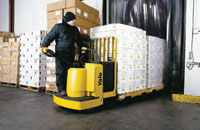Suppliers develop, improve lift truck technologies for cold environments.

By Bob Garrison
You could say some food processors and warehouse operators have a cold outlook on life. That’s because they operate refrigerated docks and frozen warehouses – tough environments that require more from material handling equipment.
Thankfully, lift truck companies are not about to turn a cold shoulder to these demanding customers. Rather, several suppliers say they have new and/or enhanced products suited for refrigerated and frozen food and warehouse applications.
Some offerings promise to make operators’ lives easier (and more productive). Still more unseen changes involve the vehicles themselves – with improvements that increase power and productivity or reduce maintenance (involving time and/or frequency). Still more offerings are using laser and computer software technologies to support warehouse operations – both in the office and out on floor.
Designed with you in mind
Toyota Material Handling, U.S.A., Inc., Irvine, Calif., says it developed its 8-Series AC reach truck line for distribution centers, refrigerated warehouses and third-party logistics applications. The line has three models including a single reach truck in 3,500- and 4,500- pound lifting capacities and a 3,000-pound capacity double reach model.
“Our 8-Series AC reach trucks feature a number of enhancements,” notes Martin Boyd, national product planning and marketing manager. “These include an AC-powered drive system, AC power hydraulic system (on 36-Volt models), and virtually maintenance-free electric disc brake – all designed to offer increased productivity and performance through faster travel speeds, reduced maintenance costs and an overall extended life cycle.”
Boyd says Toyota’s new AC-powered drive system helps operators handle more pallets per hour (and per shift) with a vehicle that reacts faster to operator commands. He adds that 8-Series reach trucks achieve faster travel times – up to 17 percent quicker than previous models. Additionally, the AC System contains no motor commutator, brushes or springs, which equates to reduced maintenance costs.
Boyd says the 36-Volt, 8-Series reach trucks come equipped with an AC hydraulic system that provides for quick, precise and efficient load handling.
He adds that 8-Series models also feature a new 11¼-inch diameter steering wheel with adjustable steering effort (compared to the previous 5¼-inch diameter design); an adjustable battery side gate retaining system to minimize battery side-to-side movement; a standard auto-position hold feature, which assists in maintaining the reach truck’s position for maximum control in push-back rack applications; cushioned hydraulics for the pantograph mechanism; and three new masts, bringing the reach truck mast height offerings up to nearly 366 inches or nearly 30.5 feet.
Another company thinking about in-rack applications is Greenville, N.C.-based Yale Materials Handling Corp., which offers a line of NR narrow aisle lift trucks with 100-percent brushless AC-powered motors, choice of two ergonomic operator compartment layouts as well as power lowering and regenerative lowering.
“Yale is more than lift trucks and maintenance. We are the total fleet management solution for our customers,” said Lou Micheletto, warehouse products manager. “The NR series provides the ergonomics, performance and serviceability to maximize and continually improve our customers’ materials handling productivity.”
Micheletto notes that Yale’s NR-EA model has lifting capacities of 3,500, 4,000 or 4,500 lbs. It is also available with an optional cooler-freezer package (0° to +120°F) or sub-zero freezer package (-40° to +120°F).
“A lift truck's cost of ownership is the largest portion of dollars spent and includes such elements as periodic maintenance, unscheduled repairs, load wheels, tires, brakes and power costs,” Micheletto adds. “The design of the Yale reach truck helps lower the operating cost of the NR-EA. Extended maintenance intervals, longer brake and tire life also play roles in lowering the overall operating costs.
Micheletto says power lowering increases operator productivity. When lowering unloaded, the motor “powers” the load down, maximizing lowering speeds. Regenerative lowering increases battery shift life. When lowering with a load, the motor generates power through regenerative braking, putting energy back into the battery.
Addressing operator ergonomics, Yale says the NR-EA offers an operator compartment with choice of side-stance or fore/aft stance and different control handle configurations. Both the side-stance and fore/aft stance operations come standard with variable on-demand electric power steering.
Color my world: lasers, fleet data
Raymond says its Reach-Fork trucks (new and old) may be fitted with new fork-tip lasers to help operators more accurately store and retrieve pallets in racks.
“When the lift truck forks are raised above 12 feet, a laser line displays on the pallet to show operators the fork position, helping lift truck operators more easily and quickly engage pallets,” says Susan Comfort, Raymond Class II product manager. “This solution is ideal for applications with tall racks, warehouses without optimum lighting, and freezer applications, and to aid newer lift truck operators.”
The fork-tip laser is available in green (for heights up to 442 inches) and red (for heights up to 300 inches). Comfort notes that the green laser is best for applications involving blue-painted pallets, brighter environments or applications where a red laser may not be clearly visible. Both fork-tip lasers are powered by the lift truck’s battery, eliminating downtime for operators to change a separate laser battery.
For its part, Crown Equipment Corp., New Bremen, Ohio, says it has done more to link a manager’s office to the warehouse floor. The company says its new Crown InfoLink 2.5 fleet management system has new features that significantly reduce false impact alarms, deliver real-time performance indicators based on user-defined goals, and display critical measurements in graphic form for at-a-glance decision making.
“There is a wealth of information being generated at the truck level and Crown InfoLink 2.5 enables our customers to organize, prioritize and manage that data to improve the productivity and efficiency of their fleet – and their entire operation via an enhanced dashboard interface,” says Maria Schwieterman, product manager for the Crown Insite Productivity Suite.
Schwieterman says InfoLink’s new interactive interface helps busy managers quickly identify and prioritize issues around compliance, impacts and equipment. Color-coded opportunity indicators provide an easy-to-monitor view of whether conditions in each area are meeting established goals (green), require attention (yellow), or need immediate action (red). Dashboard views deliver a graphical overview of performance based on the user-defined operating range for each opportunity. Drill-down reports present a more detailed analysis of areas such as service efficiency, equipment use and operator performance.
Crown says InfoLink 2.5 also features a new intelligent impact sensing system that combines data from the impact sensor and the truck to provide more accurate and meaningful impact alarms. Current approaches to impact sensing treat every event that triggers the sensor equally, which creates nuisance alarms that can mask or misrepresent actual conditions. With Crown Impulse Technology, only those impacts that meet user-defined criteria, based on truck operating data, trigger alarms.
“Working with our customers, we’ve discovered that as many as 70 percent of impact alarms are considered nuisance alarms,” said Schwieterman. “That frustrates managers and reduces their ability to use impact sensing to improve safety and reduce costs. Crown Impulse Technology makes sure they only receive alarms for events they define as impacts, while the InfoLink interface provides an easy-to-monitor visual cue for when impacts require management attention.”
